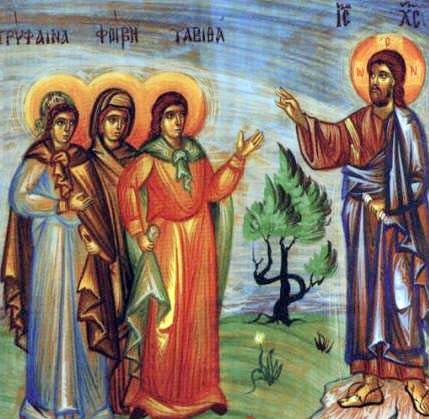The role of women in the Eastern Orthodox Church (Part 1)
16 Φεβρουαρίου 2010
The Christian world is currently divided, as it has been since the institution of the Church, on the issue of women serving in the Church and the extent to which they should serve. Certain denominations allow the ordination of women while others, relying on Holy Tradition, are resolute in their stance that only men should be ordained into the ministry. This article attempts to provide insights into, and is an exposition and analysis of what the Eastern Orthodox Church has to say on this somewhat delicate subject and what the image of women was in the Early Church.
Priesthood is an area which was previously the domain of only men. It is now an area of “equal opportunity” in many Christian Churches. The Eastern Orthodox Church or Ekklesia however, remains resolute in its stance on the issue of priesthood and allows only males to become ordained as per its interpretation of the Holy Scriptures and Holy Traditions. The Holy Scriptures which were Divinely inspired writings and Holy Tradition which was an oral transmission of Divine Truth, are for the adherents of Eastern Orthodoxy and the Ekklesia, nothing less than the Revelation of the Triune Godhead.
The Ekklesia is an institution which is “Catholic” in that it is universal and promotes unity and freedom. It is an instrument of God’s which helps to control, direct and purify mankind. The Orthodox Church is a conservative Ekklesia and yet offers her adherents enormous freedom which is embedded in the Holy Scriptures and Holy Tradition which serve as her guides. She is guided by the Paraclete or Holy Spirit. She has a definite outlook on life and clearly understands the interdependence of men and women whose relations with the Triune Godhead can never be seen in isolation from their relationships in society (Zernov 1947 : 68-70). The Ekklesia embodies Divine Sofia or wisdom and is the conscience of her adherents. Men and women are embraced equally by her, but it is only men who may become ordained as priests. Why is this so given that women were also deaconesses for a couple of centuries ?
The Apostles who were endowed with the charis (Gifts) of the Holy Spirit as the Paraclete (Comforter), were able to continue the redemptive work of Jesus Christ through their priesthood which they obtained from Him. Jesus led them to “glory” (Hebrews 2 :10) and they became “the fathers in Christ Jesus through the Gospel” (1 Corinthians 4 : 14-15) of all those who received their teachings . They established the early communities of the Church and spoke with authority which was God-given. Paul explains that the Apostles are the spiritual fathers of all believers. The Apostles were unable to deal with everything in their lives and thus entrusted many of their pastoral duties to Presbyteroi who acted on their behalf. These men were appointed by ordination and were responsible for worship and administration but gradually allowed women to help them in the latter regard.
The Ekklesia as it spread in the Greco-Roman world and indeed today, is a body made up of separate and unique individuals each of whom has a particular talent that can be utilized for the benefit of the entire ecclesiastical community irrespective of the race, nationality or socio-economic standing in society of its individual members.
No one person is considered to be superior to another or have a greater role or function to fulfill. In 1 Corinthians 12 : 25, we see the reason for the Ekklesia : “that there may be no discord in the body, but that the members may have the same care for one another”. Even Jesus Christ as the Head of the Ekklesia which is His body serves: “I am among you as one who serves” (Luke 22 : 27). Every believer has to mould his/her life to conform with God’s Word and must work out his/her “own salvation with fear and trembling” (Philippians 2 : 12). God desires that mankind including both men and women must be saved and to this end: “you are all one in Christ Jesus” (Galatians 3 : 28). Men and women have very distinct responsibilities within the Ekklesia. Contrary to what many believe, the woman’s role and function is no less than the man’s but it is clearly different. Men are called to lead worship according to Paul : “I desire then that in every place the men should pray, lifting holy hands without anger or quarrelling” (1 Timothy 2 : 8). Women on the other hand are ordered to keep silent and are not permitted to have authority over men or to teach (1 Timothy 2 : 9 – 12). The Ekklesia has faithfully maintained this tradition in terms of priesthood and it is attested to in the Gospels and the Acts of the Apostles. Christ clearly chose those whom He willed (Mark 3 : 13 – 14; John 6 :70). He did so in conjunction with the Paraclete and God the Father (Acts 1 : 2) after intense prayer (Luke 6 : 12). Male priests became intimately associated with the mission of Jesus Christ as the Incarnate Logos (Mark 16 : 14 – 15). The Apostles also prayed before selecting and appointing their assistants (1 Timothy 3 : 1 – 13 ; 2 Timothy 1: 6).
Consequently modern-day priests, as the successors of the Apostles, share in the priestly office and not women. No women were among the Twelve Apostles or amongst their successors. This was a contrast to what was occurring in other early religions however, where the idea of priestesses was not uncommon in the Levant. In Rome one would come into contact with the Vestal Virgins while in Delphi there was an oracle served by priestesses. In the early Church women were not denied priesthood because of sexism or chauvinism but by the plan of the Triune Godhead.
To be continued…




